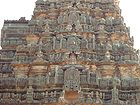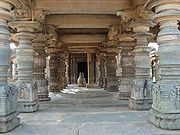.gif)
Mahadeva Temple (Itagi)
Encyclopedia

Koppal district
Koppal district is an administrative district in the state of Karnataka in India. In the past Koppal was referred to as 'Kopana Nagara'. Hampi, a World heritage center, covers some areas of Koppal District. It is situated approximately 38 km away...
, in North Karnataka
North Karnataka
North Karnataka is an arid plateau from elevation in the Karnataka state of southwest India. It is drained by the Krishna River and its tributaries the Bhima, Ghataprabha, Malaprabha, and Tungabhadra...
, Karnataka
Karnataka
Karnataka , the land of the Kannadigas, is a state in South West India. It was created on 1 November 1956, with the passing of the States Reorganisation Act and this day is annually celebrated as Karnataka Rajyotsava...
, India
India
India , officially the Republic of India , is a country in South Asia. It is the seventh-largest country by geographical area, the second-most populous country with over 1.2 billion people, and the most populous democracy in the world...
. It is about 7 km from Kuknur
Kuknur
Kuknur is in Yalaburga taluk in Koppal District, is a small town. is located about 40 km from Hospet and 7 km from Mahadeva Temple , Kuknur is renowned for its temples of the Rastrakutas and Chalukyas times, of these the Navalinga group of temples is famous.-History:Kuknur town was an...
. It is near to Lakkundi
Lakkundi
Lakkundi in Gadag District of Karnataka is a tiny village on the way to Hampi from Hubli. Lakkundi 11 km from Gadag in the east...
about 20 km.
Itagi is famous for the Chalukya style Mahadeva Temple. Most beautiful and one of the great tourist place in North Karnataka
North Karnataka
North Karnataka is an arid plateau from elevation in the Karnataka state of southwest India. It is drained by the Krishna River and its tributaries the Bhima, Ghataprabha, Malaprabha, and Tungabhadra...
, and is the finest testimonial for Vishwakarma Sthapathis in sculpting this temple
Mahadeva Temple

The Mahadeva Temple was built based on The general plan of the Amruteshwara Temple at Annigeri
Annigeri
Annigeri is a town in Navalgund taluk of Dharwad district in the state of Karnataka, India, located 20 km west of Gadag en route to Hubli and 35 km from Hubli-Dharwad.-Introduction:...
(used as the prototype). The Mahadeva Temple has the same architectural components and there is a differences in their articulation.
The Mahadeva Temple at Itagi was built in c. 1112 CE by Mahadeva, a commander (dandanayaka) in the army of the Western Chalukya King Vikramaditya VI
Vikramaditya VI
Vikramaditya VI became the Western Chalukya King after deposing his elder brother Somesvara II. Vikramaditya's reign is marked by the start of the Chalukya-Vikrama era. Vikramaditya VI was the greatest of the Western Chalukya kings and had the longest reign in the dynasty. He earned the title...
. Itagi is located about 22 miles (35 km) east of Gadag and 40 miles (64 km) west of Hampi
Hampi
Hampi is a village in northern Karnataka state, India. It is located within the ruins of Vijayanagara, the former capital of the Vijayanagara Empire. Predating the city of Vijayanagara, it continues to be an important religious centre, housing the Virupaksha Temple, as well as several other...
. The temple is dedicated to Hindu
Hinduism
Hinduism is the predominant and indigenous religious tradition of the Indian Subcontinent. Hinduism is known to its followers as , amongst many other expressions...
God Shiva
Shiva
Shiva is a major Hindu deity, and is the destroyer god or transformer among the Trimurti, the Hindu Trinity of the primary aspects of the divine. God Shiva is a yogi who has notice of everything that happens in the world and is the main aspect of life. Yet one with great power lives a life of a...
. The well-executed sculptures, finely crafted carvings on walls, pillars and the tower make it a good example of complete Western Chalukyan art
Western Chalukya architecture
Western Chalukya architecture , also known as Kalyani Chalukya or Later Chalukya architecture, is the distinctive style of ornamented architecture that evolved during the rule of the Western Chalukya Empire in the Tungabhadra region of central Karnataka, India, during the 11th and 12th centuries...
which speaks volumes about the taste of the Chalukyan artisans. An inscription dated 1112 CE in the temple calls it "Emperor among Temples" (Devalaya Chakravarti). Art critic Henry Cousens has called this monument the "finest in Kannada country after Halebidu
Halebidu
Halebidu is located in Hassan District, Karnataka, India. Halebidu was the regal capital of the Hoysala Empire in the 12th century. It is home to one of the best examples of Hoysala architecture in the ornate Hoysaleswara and Kedareswara temples. Halebidu literally means ruined city...
". These Western Chalukya monuments, regional variants of pre-existing dravida
Dravidian architecture
Dravidian architecture was a style of architecture that emerged thousands of years ago in Southern part of the Indian subcontinent or South India. They consist primarily of pyramid shaped temples called Koils which are dependent on intricate carved stone in order to create a step design consisting...
(South Indian) temples, defined the Karnata dravida tradition. The Mahadeva temple is officially protected as a national monument by the Archaeological Survey of India
Archaeological Survey of India
The Archaeological Survey of India is a department of the Government of India, attached to the Ministry of Culture . The ASI is responsible for archaeological studies and the preservation of archaeological heritage of the country in accordance with the various acts of the Indian Parliament...
.
Details


The temple plan consists of a shrine (cella) which is connected to a closed mantapa (hall) by a vestibule (antechamber). The closed mantapa leads to an open pillared mantapa, with the temple as a whole facing the east. Some parts of the temple, such as the cornice and parapet over the outer edge of the roof of the open mantapa are missing. The main temple, the sanctum of which has a linga (symbol of Shiva), is surrounded by thirteen minor shrines, each with its own linga. The temple has two other shrines, dedicated to Murthinarayana and Chandraleshwari, parents of Mahadeva, the Chalukya commander who consecrated the temple.
Mantapa (hall)

Dambal
Dambal is a village in the Gadag district of the state of Karnataka, India. It was an ancient center of Buddhism and remained so as late as the 12th century.Dambal is at an elevation of 590 metres and its population is 21,096.-History:...
and the lathe-turned pillars (whose rounded sections are lathe turned) at the Kasivisvesvara Temple at Lakkundi
Lakkundi
Lakkundi in Gadag District of Karnataka is a tiny village on the way to Hampi from Hubli. Lakkundi 11 km from Gadag in the east...
.
The square ceiling of the open mantapa which are supported by the four central pillars exhibits interesting fretted stonework. The ceiling here has been worked into a decorative arabesque
Arabesque
The arabesque is a form of artistic decoration consisting of "surface decorations based on rhythmic linear patterns of scrolling and interlacing foliage, tendrils" or plain lines, often combined with other elements...
foliage and makaras (mythical beasts) which flow from the mouth of a Kirtimukha (gargoyle
Gargoyle
In architecture, a gargoyle is a carved stone grotesque, usually made of granite, with a spout designed to convey water from a roof and away from the side of a building thereby preventing rainwater from running down masonry walls and eroding the mortar between...
or demon face). This type of stonework is considered as high a quality as any. In stark contrast, the interior of the closed mantapa and the sanctum are plain and simple. It is believed that bracket figures that once adorned the outside pillars are now missing. These forward leaning bracket figures (Salabhanjika
Salabhanjika
Salabhanjika refers to the sculpture of a woman, displaying stylized feminine features, standing near a tree and grasping a branch. The name of these figures comes from the Sanskrit śālabañjika meaning 'breaking a branch of a sala tree'...
), which normally represent female forms in various poses (such as dancing or adorning themselves), would have rested on small blocks on the shaft of the pillars (capital), finding support from the underside of the overhanging cornice
Cornice
Cornice molding is generally any horizontal decorative molding that crowns any building or furniture element: the cornice over a door or window, for instance, or the cornice around the edge of a pedestal. A simple cornice may be formed just with a crown molding.The function of the projecting...
via a slot in their upper end.

